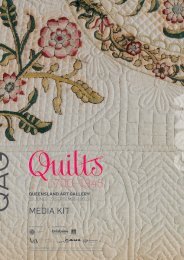Paperskin: barkcloth across the Pacific - Queensland Art Gallery
Paperskin: barkcloth across the Pacific - Queensland Art Gallery
Paperskin: barkcloth across the Pacific - Queensland Art Gallery
Create successful ePaper yourself
Turn your PDF publications into a flip-book with our unique Google optimized e-Paper software.
ACKNOWleDGMeNT<br />
i would like to acknowledge <strong>the</strong><br />
research and thoughtful input<br />
of ruth McDougall, Curatorial<br />
Assistant, Asian and <strong>Pacific</strong> <strong>Art</strong>,<br />
<strong>Queensland</strong> <strong>Art</strong> <strong>Gallery</strong> / <strong>Gallery</strong> of<br />
Modern <strong>Art</strong> to ‘<strong>Paperskin</strong>’.<br />
eNDNOTes<br />
1 Peter sharrad, ‘Trade and<br />
textiles in <strong>the</strong> <strong>Pacific</strong> and india’,<br />
in Diana Wood Conroy and<br />
emma ru<strong>the</strong>rford, Fabrics<br />
of Change: Trading Identities<br />
[exhibition catalogue], university<br />
of Wollongong, NsW, p.14.<br />
2 see Adrienne Kaeppler,<br />
‘The structure of Tongan<br />
<strong>barkcloth</strong> design’, in <strong>Pacific</strong><br />
<strong>Art</strong>: Persistence, Change and<br />
Meaning, Anita herle, Nick<br />
stanley, Karen stevenson and<br />
robert l Welsch (eds), Crawford<br />
house Publishing, hindmarsh,<br />
sA, 2002, pp.291–309.<br />
3 John Pule in John Pule and<br />
Nicholas Thomas, Hiapo:<br />
Past and Present in Niuean<br />
Barkcloth, university of Otago<br />
Press, Dunedin, 2005, p.47.<br />
4 simon Kooijman in his seminal<br />
and often quoted 1972 text on<br />
<strong>barkcloth</strong>, Tapa in Polynesia,<br />
thought that fur<strong>the</strong>r study was<br />
needed on <strong>the</strong> names given to<br />
<strong>barkcloth</strong> patterns to decipher<br />
some of <strong>the</strong> meanings, but<br />
concluded that, ‘in <strong>the</strong> present<br />
state of our knowledge<br />
<strong>the</strong>y have no interpretative<br />
significance’ and <strong>the</strong>refore did<br />
not include any. There has been<br />
some attempt at adding to this<br />
body of knowledge, but by and<br />
large, <strong>the</strong>re remains remarkably<br />
little written information on<br />
<strong>barkcloth</strong> motifs <strong>across</strong><br />
Polynesia and Melanesia.<br />
One pertinent example is rod<br />
ewins’s 1982 research on<br />
Fijian motifs (originally related<br />
to mats) and his more recent<br />
study of <strong>the</strong>se in Staying Fijian:<br />
Vatulele Island Barkcloth and<br />
Social Identity, Crawford house<br />
Publishing, hindmarsh, sA,<br />
and university of hawaii Press,<br />
honolulu, 2009.<br />
5 Drusilla Modjeska, ‘This<br />
place, our art’, in Omie: The<br />
Barkcloth <strong>Art</strong> of Omie, [exhibition<br />
catalogue], Annandale Galleries,<br />
sydney, 2006, p.16.<br />
6 Modjeska, in Omie: The<br />
Barkcloth <strong>Art</strong> of Omie, p.16.<br />
rod ewins, speaking on Fijian<br />
masi (<strong>barkcloth</strong>), also states:<br />
‘Thus it is <strong>the</strong> totality of <strong>the</strong><br />
pattern that gives meaning,<br />
and no one component of <strong>the</strong><br />
pattern can carry more than a<br />
small part of <strong>the</strong> meaning by<br />
itself’, in Staying Fijian: Vatulele<br />
Island Barkcloth and Social<br />
Identity, p.147.<br />
7 Omie: The Barkcloth <strong>Art</strong> of<br />
Omie, p.29.<br />
8 Caption details: Siapo mamanu,<br />
samoa, <strong>barkcloth</strong>, dye / 173.5 x<br />
128.2cm / Collected by sir Guy<br />
richardson Powles c.1949–60.<br />
Gift of Michael Powles, 2001 /<br />
Collection: Museum of New<br />
Zealand Te Papa Tongarewa<br />
9 Nicholas Thomas, ‘The case<br />
of <strong>the</strong> misplaced ponchos:<br />
speculations concerning <strong>the</strong><br />
history of cloth in Polynesia’,<br />
in Clothing <strong>the</strong> <strong>Pacific</strong>, Chloe<br />
Colchester (ed.), berg, Oxford,<br />
2003, p.90.<br />
10 simon Kooijman, Tapa in <strong>the</strong><br />
<strong>Pacific</strong>, bernice P. bishop<br />
Museum bulletin 234, bishop<br />
Museum Press, honolulu,<br />
hawai‘i, 1972, p358.<br />
11 roger Neich and Mick<br />
Pendergrast, <strong>Pacific</strong> Tapa, David<br />
bateman, Auckland Museum,<br />
Auckland, 1997, p.136.<br />
12 Chris ballard, email to <strong>the</strong><br />
author, 4 March 2009.<br />
13 rod ewins has also observed<br />
that human remains were<br />
found wrapped in black masi in<br />
a mortuary cave in Vanualevu,<br />
Fiji, in Staying Fijian: Vatulele<br />
Island Barkcloth and Social<br />
Identity, p.138.<br />
14 Most of Papua New Guinea,<br />
<strong>the</strong> outer islands and parts of<br />
<strong>the</strong> solomon islands have been<br />
inhabited for over 40 000 years.<br />
The rest of <strong>the</strong> <strong>Pacific</strong> was settled<br />
by speakers of Austronesian<br />
languages from south-east<br />
Asia approximately 4000 years<br />
ago. This expansion is marked,<br />
in particular, by <strong>the</strong> distinctive<br />
Barkcloth (detail) 19th century<br />
Papua New Guinea<br />
Doriri people, Oro Province<br />
Barkcloth, dye / 57.6 x 117.3cm /<br />
Collected by Captain F.R. Barton,<br />
1901. Donated 1966 / Collection:<br />
<strong>Queensland</strong> Museum<br />
pottery style known as lapita.<br />
15 it includes work by <strong>the</strong> simbali<br />
people in <strong>the</strong> south of <strong>the</strong><br />
Gazelle Peninsula, <strong>the</strong> Chachet<br />
in <strong>the</strong> north-west, and <strong>the</strong><br />
uramot and Kairak people in<br />
<strong>the</strong> central and central-east<br />
regions of <strong>the</strong> tip of this New<br />
britain island.<br />
16 see W.J. read, ‘A snake dance<br />
of <strong>the</strong> baining’, in Oceania,<br />
vol. 3, 1931–32, pp.232–37.<br />
17 harold Gallasch, letter to <strong>the</strong><br />
author, 20 July 2009.<br />
18 Karl hesse and Theo Aerts,<br />
Baining Life and Lore, university<br />
of Papua New Guinea Press,<br />
Port Moresby, 1996, p.41.<br />
19 hesse and Aerts, Baining Life<br />
and Lore, p.41.<br />
20 21

















